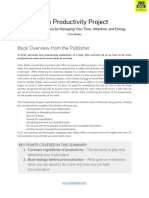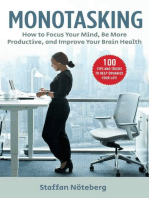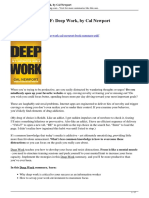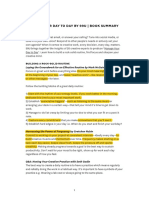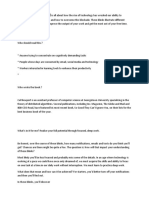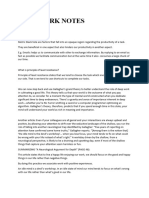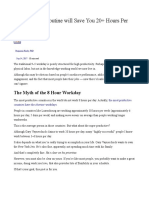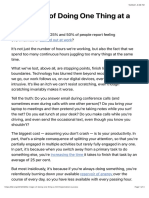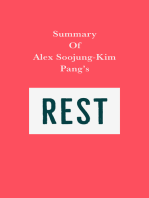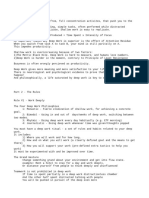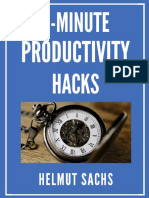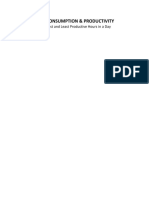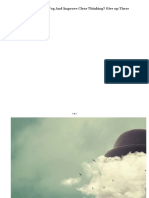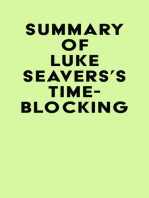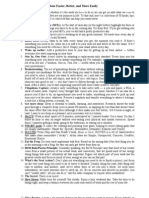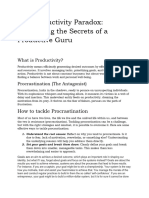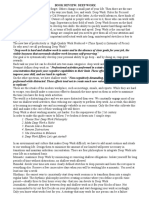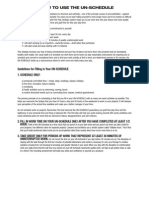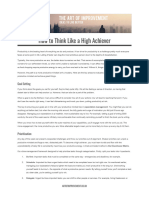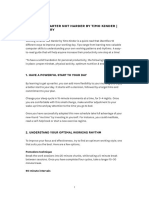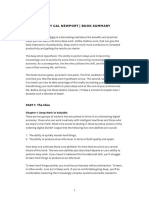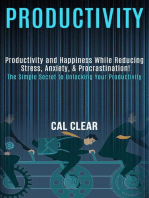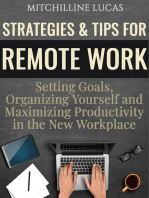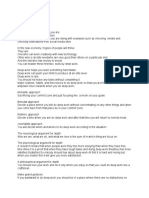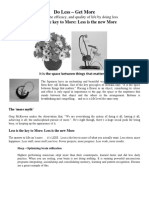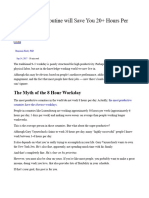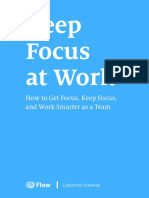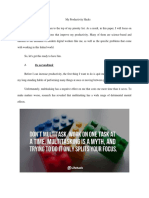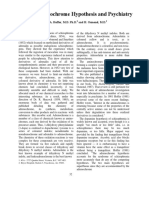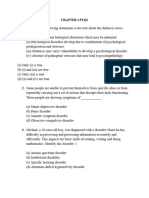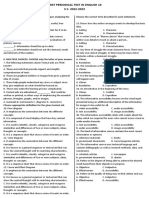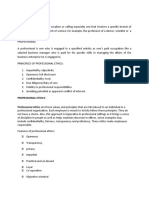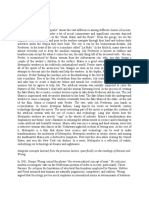Manage Your Day To Day
Manage Your Day To Day
Uploaded by
noger13294Copyright:
Available Formats
Manage Your Day To Day
Manage Your Day To Day
Uploaded by
noger13294Original Title
Copyright
Available Formats
Share this document
Did you find this document useful?
Is this content inappropriate?
Copyright:
Available Formats
Manage Your Day To Day
Manage Your Day To Day
Uploaded by
noger13294Copyright:
Available Formats
Insights from Manage Your Day‐to‐Day by Jocelyn Glei
If you had to complete a significant work project in the next two weeks ‐ a keynote speech, a school paper, a book proposal, a website,
or a software program ‐ how would you optimize your creativity and maximize your productivity?
Jocelyn Glei and her team at 99U consulted some of the brightest minds in the productivity space, such as Seth Godin, Cal Newport,
Gretchen Rubin, and Steven Pressfield, to find answers. These productivity experts highlighted four critical choices. If you spot these four
choices in your work life and consistently make the right choices, you'll give yourself the best chance to do your best work.
Choice #1: A little every day or a bunch at once?
When life is busy, it's easier to block out a Saturday or Sunday to work on a project than to make time each day.
But spreading your project time across several days will make you significantly more productive and creative thanks to the power of
frequency.
1. Daily frequency helps you get started: If you plan to work every day, even just for a few minutes, you create a work cadence
and build momentum you can bring into the next day to bypass procrastination.
2. Daily frequency helps you avoid interruptions: When you work a little each day, you can work in short bursts. And when you
work in short bursts, it’s easier to delay distractions (most demands can wait 30‐45 minutes while you focus on your project).
3. Daily frequency leads to great ideas: The more often you step away from a project, the more your subconscious works on
problems related to your project and discovers creative solutions.
Therefore, whatever time you have to complete a project, divide it across several days and put in at least 15 minutes of project work every
day no matter what.
Choice #2: Creative or reactive mode first?
Work‐life oscillates between two modes, reactive and creative. In reactive mode, we respond to problems and
requests from others. In creative mode, we temporarily block out the world and focus on creating original work. Since checking emails is
like pulling a slot machine lever (we don’t know if our inbox contains boring messages or exciting developments until we check it), we tend
to enter reactive mode as soon as possible. However, going into reactive mode and responding to messages creates attention residue for
the rest of the day as our minds are left wondering what people think of what we just said, what else we could have said, and what the
responses might be. This attention residue impairs our ability to concentrate fully on complex projects.
We must give our highest priority projects our freshest attention, which occurs in the morning when distractions are minimal and a full
night’s sleep has restored our ability to focus. To achieve optimal productivity and creativity, create first and react second.
"It’s better to disappoint a few people over small things, than to surrender your dreams for an empty inbox. Otherwise, you’re
sacrificing your potential for the illusion of professionalism.” ‐ Mark McGinnis
Choice #3: Rigid or flexible?
The most productive and creative people have learned extreme discipline is needed to unleash creativity. As
author David Brooks said, “Great creative minds think like artists, but work like accountants.”
Aim to execute the first five minutes of your project work sessions in the exact same way every time. Stephen King, for instance, sits at the
same desk, at the same time every day, takes the same vitamin pill, and listens to the same music. He arranges the papers on his desk in the
same manner to kickstart his creative writing session. King says, “The cumulative purpose of doing these things the same way every day
seems to be a way of saying to the mind, you’re going to be dreaming soon.” Starting the same way every time is a form of self‐induced
Pavlovian training. The more you get into a deep work state after a starting sequence, the more your mind associates that state with that
starting sequence. You start tuning out distractions and getting your mind into a deep work mode the instant you initiate your work
sequence.
What sequence of actions will you execute to reliably trigger a deep and creative work state?
Choice #4: Sustain or cycle?
The longer you remain seated and focus on a task, the shallower you breathe, and the less oxygen gets to your
brain. Therefore, quickly step away from your work and cycle your attention every 20 minutes. Quickly stepping away from your work to
get a drink of water, walk around the block, or go to the bathroom to splash water on your face allows you to consciously regulate your
breathing and get more oxygen to your brain (so you can extend your focus session). During your mini work breaks perform “box
breathing” like Navy Seals do before combat – take a deep four second inhale, hold for four seconds, exhale for four seconds, and hold for
another four seconds. Repeat for the entire work break.
When you move during your mini work break, you can replenish the neurochemicals you need to focus. Dr. Andrew Huberman says,
“Physical movement activates pathways in the brain that increase dopamine, which is the basis for epinephrine (aka, adrenaline) and all
neural energy.” In other words, a short movement period can provide the fuel to focus intensely and continue producing at a high level.
www.ProductivityGame.com
You might also like
- Productivity Project PDFDocument10 pagesProductivity Project PDFjeff50% (2)
- Shortform Summary - Deep WorkDocument28 pagesShortform Summary - Deep WorkRahul Gupta100% (7)
- Deep Work by Cal Newport - Book Summary & PDF by 2000 BooksDocument8 pagesDeep Work by Cal Newport - Book Summary & PDF by 2000 BooksGagan JhaNo ratings yet
- How To Be A High School SuperstarDocument5 pagesHow To Be A High School Superstarsparklefrog67% (3)
- Monotasking: How to Focus Your Mind, Be More Productive, and Improve Your Brain HealthFrom EverandMonotasking: How to Focus Your Mind, Be More Productive, and Improve Your Brain HealthNo ratings yet
- Deep Work Cal Newport Book Summary PDFDocument17 pagesDeep Work Cal Newport Book Summary PDFhuihzhoiero100% (2)
- Sums The Accidental Creative PDFDocument10 pagesSums The Accidental Creative PDFGigi Ion100% (1)
- 10 Quick Tips: To Improve Your Productivity at WorkDocument12 pages10 Quick Tips: To Improve Your Productivity at WorkGaryNo ratings yet
- Manage Your Day To Day by 99U Book SummaryDocument6 pagesManage Your Day To Day by 99U Book SummaryTrí Nguyễn100% (1)
- Deep Work - Cal NewportDocument11 pagesDeep Work - Cal NewportBobNo ratings yet
- Deep Work v.1.2Document10 pagesDeep Work v.1.2Abhijeet SrivastavaNo ratings yet
- Manage Your Day To Day by 99U - Book Summary by Paul MinorsDocument13 pagesManage Your Day To Day by 99U - Book Summary by Paul Minorsbalaji817150No ratings yet
- Notes On Deep Work and Focus and Meaningful ProductivityDocument15 pagesNotes On Deep Work and Focus and Meaningful ProductivityMarc Gris100% (1)
- Improving Focus at WorkDocument7 pagesImproving Focus at Workpphande3498No ratings yet
- Deep Work (2016)Document5 pagesDeep Work (2016)Vishan Singh100% (2)
- Deep Wok SummaryDocument5 pagesDeep Wok SummaryAhmedNo ratings yet
- Deep Work NotesDocument4 pagesDeep Work NotesPrityush DidwaniyanNo ratings yet
- Work IQDocument50 pagesWork IQDean Deodato DekovićNo ratings yet
- Impecable RutinasDocument8 pagesImpecable RutinasmaggielisabNo ratings yet
- The Magic of Doing One Thing at A TimeDocument3 pagesThe Magic of Doing One Thing at A Timevenu4u498No ratings yet
- Deep Work SummaryDocument4 pagesDeep Work Summarybondarenkoyuri3No ratings yet
- 12 Mind Hacks To Improve Your FocusDocument1 page12 Mind Hacks To Improve Your FocusBrindusacNo ratings yet
- This Morning Routine Will Save You 20 Hours Per WeekDocument9 pagesThis Morning Routine Will Save You 20 Hours Per Weekmkm_64No ratings yet
- 5 Minute Productivity HacksDocument8 pages5 Minute Productivity HacksPaul Samson TopacioNo ratings yet
- Time Consumption & Productivity: The Most and Least Productive Hours in A DayDocument13 pagesTime Consumption & Productivity: The Most and Least Productive Hours in A DayAngel Mae CabungcalNo ratings yet
- From Leo Babauta of Zen Habits:: What Are You Doing in This Moment?Document32 pagesFrom Leo Babauta of Zen Habits:: What Are You Doing in This Moment?jonlefaveNo ratings yet
- Deep Work Summary by Cal NewportDocument10 pagesDeep Work Summary by Cal NewportR.Gopikaramanan - DDD100% (6)
- Want To Reduce Brain Fog and Improve Clear Thinking? Give Up These Things ImmediatelyDocument5 pagesWant To Reduce Brain Fog and Improve Clear Thinking? Give Up These Things ImmediatelyG21 Data100% (1)
- Claritatea MintiiDocument6 pagesClaritatea MintiimarianNo ratings yet
- Deep Work PDF (Resume)Document11 pagesDeep Work PDF (Resume)mitsurini100% (2)
- ScriptDocument4 pagesScriptPrincess Fatima De JuanNo ratings yet
- Deep WorkDocument15 pagesDeep WorkNemuel KesslerNo ratings yet
- 50 Tricks To Get Things Done Faster, Better, and More EasilyDocument4 pages50 Tricks To Get Things Done Faster, Better, and More EasilyDevendra Kumar Choudhary100% (1)
- Essay For ChroniclesDocument3 pagesEssay For ChroniclesMuhammad AhmadNo ratings yet
- Book ReviewDocument2 pagesBook ReviewVinh Dao CongNo ratings yet
- Now Habit EnhancedDocument15 pagesNow Habit EnhancedDaniel S. CruzNo ratings yet
- How To Think Like A High AchieverDocument2 pagesHow To Think Like A High AchieverPRANAV NARAYANANNo ratings yet
- Working Smarter Not Harder Book Summary and PDFDocument7 pagesWorking Smarter Not Harder Book Summary and PDFОуен УнаNo ratings yet
- Mindful Productivity Audit Ness Labs UpdatedDocument9 pagesMindful Productivity Audit Ness Labs UpdatedjoNo ratings yet
- Calm Achiever Busy People MistakesDocument7 pagesCalm Achiever Busy People MistakesAnshumali Saxena100% (1)
- Time Management Is A MythDocument30 pagesTime Management Is A MythKarolNo ratings yet
- Deep Work by Cal Newport Book SummaryDocument8 pagesDeep Work by Cal Newport Book SummaryTrí Nguyễn86% (22)
- Pocket - Too Much Focusing Is Draining. Here's A Better StrategyDocument5 pagesPocket - Too Much Focusing Is Draining. Here's A Better Strategyvlado.maksimovicNo ratings yet
- Productivity: Productivity and Happiness While Reducing Stress, Anxiety, & Procrastination! (the Simple Secret to Unlocking Your Productivity)From EverandProductivity: Productivity and Happiness While Reducing Stress, Anxiety, & Procrastination! (the Simple Secret to Unlocking Your Productivity)No ratings yet
- Strategies & Tips for Remote Work: Setting Goals, Organizing Yourself and Maximizing Productivity in the New WorkplaceFrom EverandStrategies & Tips for Remote Work: Setting Goals, Organizing Yourself and Maximizing Productivity in the New WorkplaceNo ratings yet
- Deep Work SummaryDocument3 pagesDeep Work SummaryRitaNo ratings yet
- 1.3.04 - Do Less Get MoreDocument4 pages1.3.04 - Do Less Get MorePrabath Withanage100% (1)
- Impecable RutinasDocument8 pagesImpecable RutinasmaggielisabNo ratings yet
- Time Management Secrets TipsDocument7 pagesTime Management Secrets TipsYouNes MaarefNo ratings yet
- Deep Focus at WorkDocument56 pagesDeep Focus at Workemirav2No ratings yet
- Deep Focus at Work PDFDocument56 pagesDeep Focus at Work PDFGabrielAlvarezGomezNo ratings yet
- Procrastination - Stop F#cking Procrastinating and Do Some F#cking Work! PDFDocument172 pagesProcrastination - Stop F#cking Procrastinating and Do Some F#cking Work! PDFspiridon_andrei2011100% (3)
- Traqueña Cleo Mae C. Cw2m1Document13 pagesTraqueña Cleo Mae C. Cw2m1Cleo Mae TraqueñaNo ratings yet
- Your Brain at Work (Review and Analysis of Rock's Book)From EverandYour Brain at Work (Review and Analysis of Rock's Book)Rating: 4 out of 5 stars4/5 (1)
- Choosing The Perfect Topic For A Research Project Can Feel OverwhelmingDocument5 pagesChoosing The Perfect Topic For A Research Project Can Feel OverwhelmingNelson BandoyNo ratings yet
- Adrenochrome Hypothesis and PsychiatryDocument14 pagesAdrenochrome Hypothesis and PsychiatryErik KammlerNo ratings yet
- Chapter 4 PYQDocument14 pagesChapter 4 PYQVanshika ChughNo ratings yet
- DLL Fos Week 3Document3 pagesDLL Fos Week 3Mary Rose IlaganNo ratings yet
- Entrepreneur QualitiesDocument16 pagesEntrepreneur QualitieshvrkNo ratings yet
- Oral Reading Reading Comprehension Reading Passage For Pre Test DataDocument3 pagesOral Reading Reading Comprehension Reading Passage For Pre Test DataLiza DalisayNo ratings yet
- Prose Analysis (Chapter 1-10)Document21 pagesProse Analysis (Chapter 1-10)Edo WNo ratings yet
- Introduction To Children With ExceptionalitiesDocument23 pagesIntroduction To Children With Exceptionalitiescraine493No ratings yet
- Topics For High School EssaysDocument5 pagesTopics For High School Essaysrlxaqgnbf100% (2)
- Third Year Mental Health Nursing 34-50Document17 pagesThird Year Mental Health Nursing 34-50Nosy ParkerNo ratings yet
- Academic Self-Efficacy As Predictor of Academic Achievement: Abd Basith, Andi Syahputra, Muhammad Aris IchwantoDocument9 pagesAcademic Self-Efficacy As Predictor of Academic Achievement: Abd Basith, Andi Syahputra, Muhammad Aris IchwantoNora Tri AnggrainiNo ratings yet
- 2nd Bac Gerund and Infinitive - A Summary and PracticeDocument5 pages2nd Bac Gerund and Infinitive - A Summary and Practiceeasyenglishkhaled1No ratings yet
- 5 Academic Honesty PPT and WorkshopDocument30 pages5 Academic Honesty PPT and WorkshopethanqianNo ratings yet
- 5Es-Detailed-Lesson-Plan Science 5 - W2Document8 pages5Es-Detailed-Lesson-Plan Science 5 - W2Jackie Rubina Orphiano100% (1)
- UCSPDocument3 pagesUCSPMAY VILLAFUERTENo ratings yet
- Summative Test 2022Document2 pagesSummative Test 2022NOEL MENDOZANo ratings yet
- The WaltzDocument11 pagesThe WaltzIVANNADRAGNEELNo ratings yet
- 2289 - Hyper Reality BoudrilardDocument3 pages2289 - Hyper Reality BoudrilardMatthew ReevesNo ratings yet
- G9 - Literature Review EditedDocument11 pagesG9 - Literature Review EditedNguyen Kim NganNo ratings yet
- Problem SolvingDocument55 pagesProblem SolvingHardik SNo ratings yet
- Chapter 9 Notes - Multivariate CorrelationsDocument6 pagesChapter 9 Notes - Multivariate CorrelationsKristen StarksNo ratings yet
- Unit 3Document7 pagesUnit 3Koustov ChoudhuryNo ratings yet
- The Analytical A Priori & Synthetic A PosterioriDocument14 pagesThe Analytical A Priori & Synthetic A PosterioriSatranc SatrancNo ratings yet
- Metropolis MovieDocument2 pagesMetropolis MovieNaeemah ApionNo ratings yet
- As Biology Edexcel Coursework Mark SchemeDocument4 pagesAs Biology Edexcel Coursework Mark Schemeafjwfealtsielb100% (2)
- Falco Summers 2019Document20 pagesFalco Summers 2019Fuji YomiNo ratings yet
- Oil Refinery Maintenance Interview Questions Answers GuideDocument14 pagesOil Refinery Maintenance Interview Questions Answers GuideSingh Aditya SinghNo ratings yet
- Parent Teacher Partnership Towards Early Literacy and Numeracy DevelopmentDocument39 pagesParent Teacher Partnership Towards Early Literacy and Numeracy DevelopmentMelanie CantreNo ratings yet
- Evidence Standard 6Document4 pagesEvidence Standard 6api-679273407No ratings yet
- Hypothesis Is A Tentative Explanation That Accounts For A Set of Facts and Can Be Tested by Further InvestigationDocument9 pagesHypothesis Is A Tentative Explanation That Accounts For A Set of Facts and Can Be Tested by Further InvestigationScreaMonster PicNo ratings yet
- 2231 2 2022 03 - 1 (Sample) .HWPDocument31 pages2231 2 2022 03 - 1 (Sample) .HWPUyên PhươngNo ratings yet
